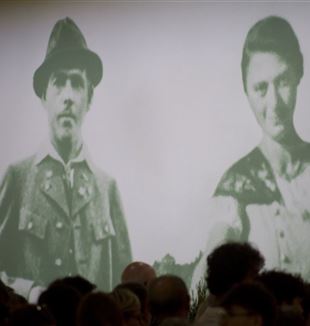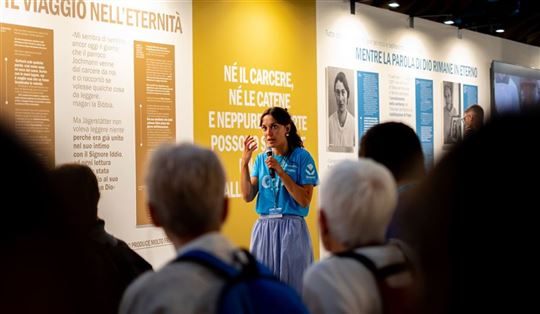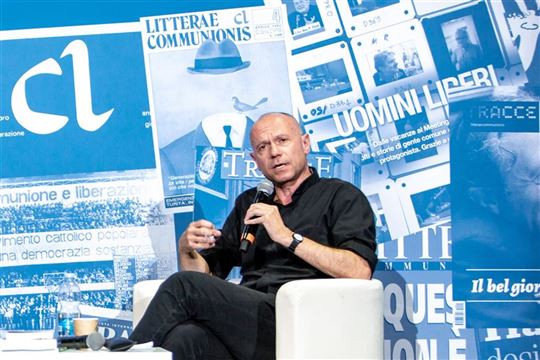
What is worth living for?
Franz Jägerstätter was put to death by the Nazis for refusing to enlist. What does his testimony tell us today? A dialogue with Father Emmanuele Silanos, among the curators of the exhibition at the Rimini Meeting.“We believe like children and act like men,” wrote Franz Jägerstätter in 1941. The following year the Austrian farmer, who lived in a small village on the Bavarian border and whom the church declared blessed in 2007, refused to fight for the Nazi cause, knowing full well that it would cost him his life. It was his simple, childlike faith that led him to this decision. It was a faith that was nurtured by and blossomed because of his relationship with his wife, Franziska, who accepted her husband’s choice and accompanied him on his Way of the Cross. Their extraordinary and at the same time normal testimony was illustrated in an exhibition, one of the most visited at the Rimini Meeting. We talked about it with one of the curators, Father Emmanuele Silanos of the Priestly Fraternity of the Missionaries of St. Charles Borromeo, who after six years of missionary work in Taiwan, has been vicar general of the institute since 2013.
What sparked your interest in Franz and Franziska?
I did not know their story until I saw Terrence Malick’s film A Hidden Life during COVID, which tells their story in an extraordinary way. I recommended it to many friends, including some families from Padua. Last year, on the death of Pope Benedict XVI, these families organized a pilgrimage to the birthplaces of Mr. and Mrs. Jägerstätter and of Ratzinger, which are only a few kilometers apart. In St. Radegund, we had the gift of meeting and talking with Maria, one of Franz’s four daughters. Both the visit and our dialogue with her struck us so much that we decided to propose an exhibition for the Meeting. Our interest was shared by some scholars from the magazine LineaTempo. The exhibition was born from the collaboration between these two groups.
Why was that visit so important?
First of all because of the dialogue with their daughter. When we asked her if she and her sisters had ever had any doubts about their father’s choice, her answer was, “No, because our mother told us that he had done well. She was right: he would not have been happy if he had not acted that way.” Then I realized that the story to be told was not just about Franz, but about Franz and Franziska, about their marriage. Something similar had happened to me with other saints: the context of the simplicity in which they lived confirms that holiness is closely linked to the everydayness of a normal life.
We can say that it is the heart of testimony.
I echo what Davide Prosperi said at the Assembly of International Responsibles: “Called, that is, sent: The beginning of mission,” which is the theme of the whole Movement’s Beginning Day. God imprints a change on history through the person, a self changed by an experience of communion, which for Franz was his relationship with Franziska. During the days of the Meeting, among the many people who came out of the exhibition moved, a dear friend, Adriano Dell’Asta, grasped the generative point of Franz’s testimony while speaking to one of the curators: “The heart of this story is the experience of mercy that invested him.” And this came through an encounter: that with Franziska. Up to that point, he had been living haphazardly, but she saved his life. We can say that for him, mercy had the face of his wife.
What significance does your encounter with Franz have for your own life?
I was struck by what Erna Putz, Franz’s biographer, said in the video recorded especially for the exhibition: “Reading the couple’s letters made me want to be a saint.” Coming across their story rekindled in me the desire for holiness, which is what all the baptized are called to. Something similar had happened to Franz as well–his path in staying true to the choice he had made was not linear. He too had doubts, not least because of external pressures. But a few weeks before his execution, the prison chaplain confided in him that a priest, Father Franz Reinisch, had suffered his own martyrdom. This news reassured him and allowed him to say, “I am on the right path.” When you find a person who embodies what you feel, who lives what you experience more deeply than you do, you say then, “it is possible for me too.” It is the same thing that happens to us when we encounter Franz and Franziska. Erna Putz again said, “Their story teaches that giving one’s life for Christ is the fulfillment of our life and gives joy.” Giving one’s life to witness to Christ gives joy: this is also the meaning of mission. And for me, as a missionary, it is a fundamental reminder. 
As you mentioned, there was no lack of doubts and disagreements. During his interrogation, the Austrian official told him that his gesture was useless, that it would not change the outcome of the war. His fellow citizens were of the same opinion, even after his death.
The official asked him why he did it, given that it would not change the outcome of the war: Did he do it to affirm a principle? No. Franz gave his life for one person, Christ, who became present in his encounter with Franziska. He offered his life to the One who saved it.
He was also told that his choice to object to the Nazi regime would remain locked in his heart. Why did his Christian conscience prompt him to make his decision public?
In Malick’s film, the parish priest who wants to dissuade him tells him, “God doesn’t care what you sayonly what is in your heart.” It is a terrible phrase, the last temptation he suffered in prison. It is terrible because it suggests a dualism between faith and life. Jesus sent the disciples to bear public witness to their faith without fear of insult. Of course, there may be certain historical circumstances that suggest prudence in exposing oneself publicly, but this prudence cannot involve collaboration with evil and the explicit rejection of testimony, otherwise it would contradict what Jesus asks of us, not to be ashamed of Him and not to be afraid, “for the Holy Spirit will teach you what you should say.” In this sense, an important factor emerges clearly from the exhibition.
Which is?
Franz did not seek martyrdom, and he did not want to abandon his family, so much so that he asked for military service in the medical department, but he was denied. Public testimony is not an ostentation, a muscular exercise, but a response to the love that takes over one’s life. Each person, within his or her vocation, is asked to give everything in what he or she does on a daily basis. For example, right now I am asked to stay in Rome to serve the Fraternity of which I am a part. This is what my “mission” consists of now, even if it seems different from when I was in Taiwan.
A focal point is Jägerstätter’s dramatic relationship with the church. The prison chaplain accompanied him in his choice, while the pastor and bishop tried hard to dissuade him.
Some facts to understand. In 1937, in his encyclical Mit Brennender Sorge, Pius XI had made it clear that it was not possible to be a Christian and a Nazi at the same time. The following year, 99% of Austrians voted for annexation to the Nazi regime in the popular referendum. A few days earlier, the Austrian Bishops’ Conference had issued a document calling for a yes vote. Franz immediately disagreed with this stance. Where did his bold stance, which contradicted his pastors, come from? First of all, from an extraordinary ability to discern, to go to the bottom of his own heart and conscience. But this was possible for him because he was deeply rooted in the faith of the church, in obedience to the pope and his magisterium. It would be wrong to say that Franz did not obey the church... in a sense, he was one of the few who really obeyed! I would add a sentence found in his writings, “If God had not given me the strength and the grace, then maybe I’d simply do the same as the majority do.” Martyrdom is a grace. It is a grace to be asked to suffer it and it is also a grace to answer yes. I heard so many people on their way out of the exhibition exclaiming, “I would not have been able to, I could not have done it.” But ultimately mission and testimony are just that: saying yes to what Christ is asking of you now. As it was for Franziska.
In his preface to the catalogue, Cardinal Zuppi called Franziska’s a “white martyrdom.”
She was only thirty years old when her husband died. Then, for seventy years, she suffered the misunderstandings and insults of her fellow villagers; she was not even granted her war widow’s pension, but above all she had to endure the silence that fell over her husband’s story. It was not until 1997 that the Austrian state rehabilitated her husband, and in that same year the beatification process began. In 2007, on the day of his beatification, Franziska kissed the urn containing Franz’s ashes and gave it to the bishop of Linz. With that gesture, it was as if she was handing the Austrian church back their son who had been forgotten for years and whose memory she alone had cherished.
In what way?
By following what Franz had written to her in his letters from prison: not holding a grudge against anyone, forgiving everyone, even those who would hurt her. She was a farmer all her life, raising her daughters and going to Mass. A simple life. Franziska lived by cherishing the memory of her husband and learning over time the reasons that had moved him. It is like that for us, too: we learn to give everything one step at a time, in the little everyday yeses, to our wife, husband, children...
Many, many people came out of the exhibition with tears in their eyes. What encounters have struck you the most?
So many. I remember one gentleman who said, “I have always been concerned about providing my family with a perfect life, but now I realize that the only thing that matters is showing them what life is worth living for.” In this sense, the comment of Paul Kahn, an American Jewish jurist and speaker at one of the meetings at the Rimini Meeting, is surprising: “The heart of this exhibition is not the sociological aspects, but the question: What does it make sense to give one’s life for?”